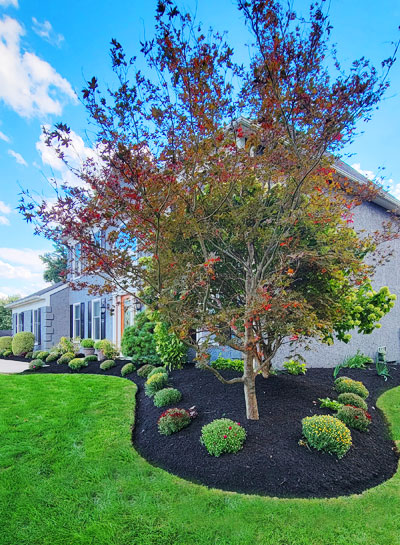Efficient Lawn Cleanup Jacksonville: Preserve a Tidy and Healthy Lawn
Efficient Lawn Cleanup Jacksonville: Preserve a Tidy and Healthy Lawn
Blog Article
Elevate Your Home's Visual With Sustainable Landscaping Designs and Eco-Friendly Practices

Benefits of Lasting Landscaping
Applying lasting landscape design practices not only conserves all-natural resources however also advertises biodiversity and enhances general environmental health. One significant advantage is the decrease of water intake through the use of drought-resistant plants, rainfall yards, and effective watering systems.
Moreover, sustainable landscape design can improve soil wellness by decreasing making use of chemical plant foods and pesticides, therefore developing a healthier atmosphere for plant development and advantageous soil organisms. This, subsequently, improves the total strength of the landscape to hold up against environmental stressors and climate modification impacts - landscaping companies Jacksonville. Additionally, sustainable landscaping practices can attract diverse wild animals, consisting of pollinators like and butterflies, promoting a much more well balanced and dynamic environment within the home
Incorporating Native Plants
To construct upon the benefits of lasting landscape design, a critical concentrate on including native plants can even more enhance eco-friendly strength and advertise biodiversity within the landscape. Indigenous plants are species that normally take place in a certain location and have actually evolved to grow in the regional climate, soil problems, and ecological community. By including indigenous plants in landscape design styles, residential property owners can minimize water use, decrease the demand for chemical pesticides and plant foods, and sustain the local wildlife population.
Integrating indigenous plants likewise aids in maintaining the unique character and identification of an area's vegetation. These plants often need less upkeep as soon as established, making them a affordable and lasting landscaping service over time. Additionally, indigenous plants can draw in native pollinators like butterflies and bees, adding to the total health and wellness of the ecological community.
When picking native plants for landscaping projects, it is necessary to choose varieties that are appropriate to the specific ecological conditions of the site. Consulting with herb yards or neighborhood baby rooms can give valuable support on selecting the right native plants for a particular area. By integrating indigenous plants right into landscape design layouts, home owners can create attractive, sustainable outside spaces that benefit both the environment and the community.

Water Conservation Techniques
Efficient irrigation methods play an important role in lasting landscaping practices, guaranteeing optimal water conservation initiatives in outside spaces. Implementing methods such as drip irrigation, rain harvesting, and wise irrigation systems can substantially reduce water wastage while preserving a healthy landscape. Leak irrigation delivers water directly to the origins of plants, minimizing dissipation and runoff. Rainwater collecting involves accumulating rainwater from roofs and saving it for later use in watering, decreasing the dependence on municipal water sources. Smart watering systems utilize weather information and dirt dampness degrees to adjust watering schedules, preventing overwatering and advertising water efficiency.
In enhancement to innovative watering methods, xeriscaping is an additional water-saving landscape design method that concentrates on making use of drought-resistant plants, mulch, and efficient irrigation to produce a low-water landscape layout - landscaping contractor Jacksonville. By picking native plants that are well-suited to the regional environment and soil conditions, building owners can lower the need for too much watering, inevitably preserving water and advertising a sustainable outdoor environment
Eco-Friendly Hardscaping Concepts
Enhancing outside areas with environment-friendly hardscaping functions can contribute considerably to lasting landscape design methods. Choose for products like recovered wood, recycled concrete, or natural rock to decrease ecological impact when thinking about hardscaping aspects. These products not just add an unique visual charm to your outdoor area however also reduce the requirement for new resources removal.
Implementing permeable leading choices such as gravel or permeable concrete can aid lower water drainage and promote groundwater recharge. These alternatives enable rainwater to seep right into the ground, protecting against erosion and minimizing the problem on stormwater systems.
Incorporating indigenous plants into hardscaping styles can better enhance eco-friendliness by supporting local wild animals and lowering the need for extreme watering or chemical therapies. By integrating environment-friendly wall surfaces or vertical yards, you can present extra plants into use this link urban setups, enhancing air high quality and biodiversity.
Including energy-efficient lights, such as solar-powered LEDs, into hardscaping styles can decrease electrical energy intake and lower your home's carbon footprint. Prioritizing environment-friendly hardscaping concepts not just enhances the elegance of your outside area yet additionally shows a commitment to ecological stewardship.
Maintenance Tips for Lasting Landscapes
:max_bytes(150000):strip_icc()/2583801_toddd_49-1-bc209c65ca1a4917afe2f2cbc437027c.jpg)
Regularly trim plants to advertise healthy development and stop overgrowth that can lead to pest diseases or infestations. Usage organic fertilizers to nurture the dirt and plants without damaging chemicals that can leach right into the atmosphere.
Conclusion
Finally, sustainable landscaping techniques provide countless advantages for homeowner, from boosting the aesthetic allure of the surroundings to promoting ecological preservation. By incorporating indigenous plants, carrying out water conservation strategies, and utilizing green hardscaping concepts, residential or commercial property owners can produce stunning landscapes that are likewise eco liable. With proper upkeep, lasting landscapes can thrive and contribute to a healthier environment for both humans and wildlife.
Furthermore, lasting landscaping can boost dirt wellness by minimizing the use of chemical fertilizers and pesticides, thus creating a much healthier setting for plant development and page useful soil organisms.To develop upon the advantages of sustainable landscape design, a calculated focus on integrating indigenous plants can further improve eco-friendly strength and promote biodiversity within the landscape. By consisting of indigenous plants in landscape company website design styles, building owners can minimize water usage, lessen the requirement for chemical pesticides and plant foods, and support the local wildlife population.
These plants often require less maintenance as soon as developed, making them a sustainable and cost-effective landscaping solution in the lengthy run. By incorporating indigenous plants into landscaping styles, building proprietors can develop stunning, lasting outdoor areas that profit both the environment and the area.
Report this page